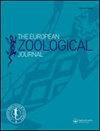The spatial structure (3D) and mechanical properties of the sponge Spongilla lacustris L. (Porifera: Spongillida) skeleton as a potential tensegral architecture
IF 1.6
4区 生物学
Q2 ZOOLOGY
引用次数: 1
Abstract
Abstract Complex biological systems often provide ready solutions for contemporary engineering. One such organism might be sponges, primitive, tissueless animals whose evolution over 600 million years has allowed them to become highly specialized. An example of such an organism is the freshwater sponge Spongilla lacustris L., an organism that filters water. This study aimed to investigate the 3D structure of the aforementioned sponge using a broad spectrum of techniques such as Microcomputed Tomography (µCT), Scanning Electron Microscopy (SEM), Confocal Laser Scanning Microscopy (CLSM), and Light Microscopy. Additionally, these techniques have been used to correlate sponge architecture with mechanical properties using the concept of tensegrity, i.e., the feature of architectural structures that self-stabilize by balancing multidirectional, often opposing, tensile and compressive forces. A more detailed look at the structure of the sponge skeleton reveals that it is based on two elements: rigid siliceous spicules, chitin in in fibres with cementing collagen-type spongin material. The coexistence of these elements in the sponge structure determines the mechanical properties and, consequently, the sponge skeleton’s postulated tensegrity. Our observations indicate that the integrity of loose megascleres is realized by sponging material surrounding the bundles of spicules. Our distinction of skeletal elements was determined by the number of spicules in the bundle, the direction of spicule position relative to the main body axis, and the way the elements were connected. The arrangement of the bundles described above has important implications for the mechanical properties of the sponge skeleton and, consequently, for the tensegrity hypothesis.湖绵海绵(Porifera: sponillida)骨骼作为一种潜在的张拉体结构的空间结构(3D)和力学性能
复杂的生物系统往往为当代工程提供现成的解决方案。一种这样的生物可能是海绵,一种原始的、无组织的动物,它们经过6亿年的进化,已经变得高度专业化。这种有机体的一个例子是淡水海绵,一种过滤水的有机体。本研究旨在研究上述海绵的三维结构,使用广泛的技术,如微计算机断层扫描(µCT)、扫描电子显微镜(SEM)、共聚焦激光扫描显微镜(CLSM)和光学显微镜。此外,这些技术已被用于使用张拉整体概念将海绵建筑与机械性能联系起来,即建筑结构的特征,通过平衡多向,通常是相反的拉伸和压缩力来自稳定。对海绵骨架结构的更详细的观察表明,它是基于两个元素:刚性硅质针状体,纤维中的几丁质与粘合胶原型海绵材料。这些元素在海绵结构中的共存决定了海绵结构的力学性能,从而决定了海绵骨架的张拉整体性。我们的观察表明,松散的大颗粒的完整性是通过海绵材料包裹在针状体束周围来实现的。我们对骨骼元素的区分是由束中针状体的数量、针状体相对于主体轴的位置方向以及这些元素的连接方式决定的。上述束的排列对海绵骨架的力学性能具有重要意义,因此也对张拉整体假说具有重要意义。
本文章由计算机程序翻译,如有差异,请以英文原文为准。
求助全文
约1分钟内获得全文
求助全文
来源期刊

European Zoological Journal
Agricultural and Biological Sciences-Animal Science and Zoology
CiteScore
3.10
自引率
5.60%
发文量
80
审稿时长
30 weeks
期刊介绍:
The European Zoological Journal (previously Italian Journal of Zoology) is an open access journal devoted to the study of all aspects of basic, comparative and applied protozoan and animal biology at molecular, cellular, tissue, organ, organismal, population, and community-ecosystem level. Papers covering multiple levels of organization and integrative approaches to study animal form, function, development, ecology, evolution and systematics are welcome. First established in 1930 under the name of Il Bollettino di Zoologia, the journal now has an international focus, reflected through its global editorial board, and wide author and readership.
 求助内容:
求助内容: 应助结果提醒方式:
应助结果提醒方式:


